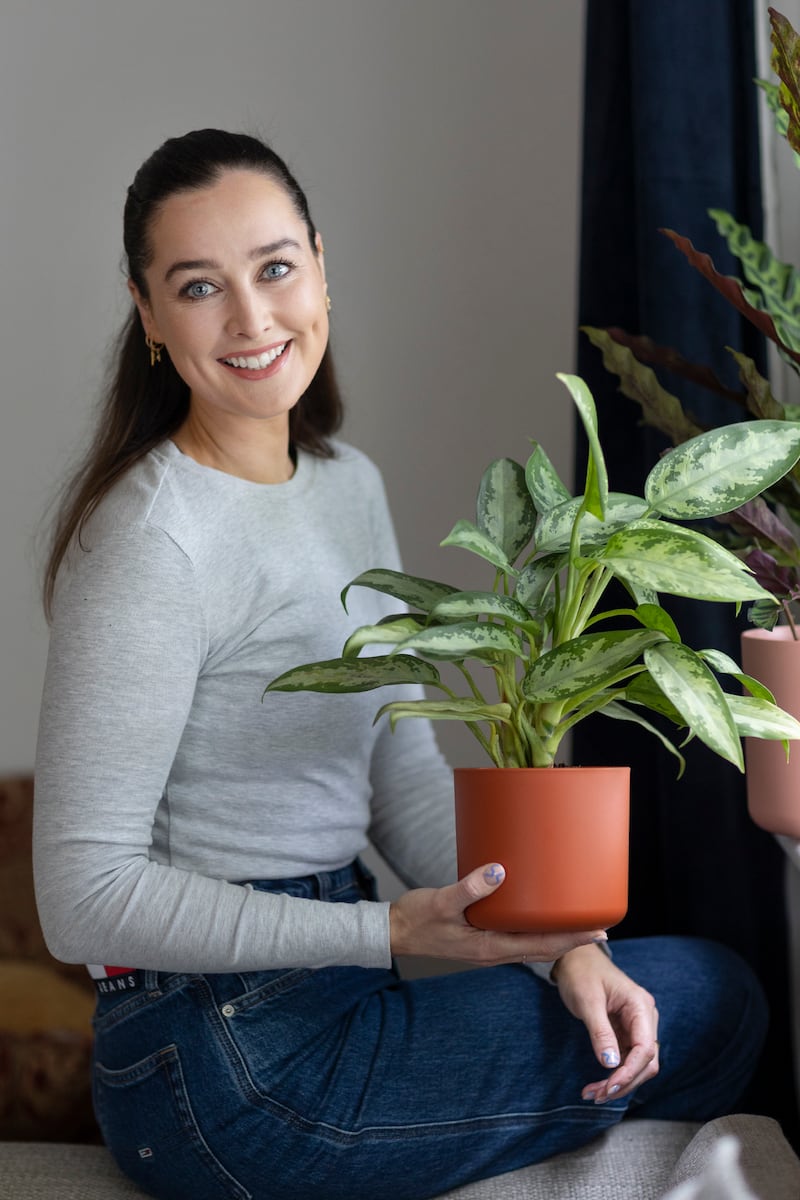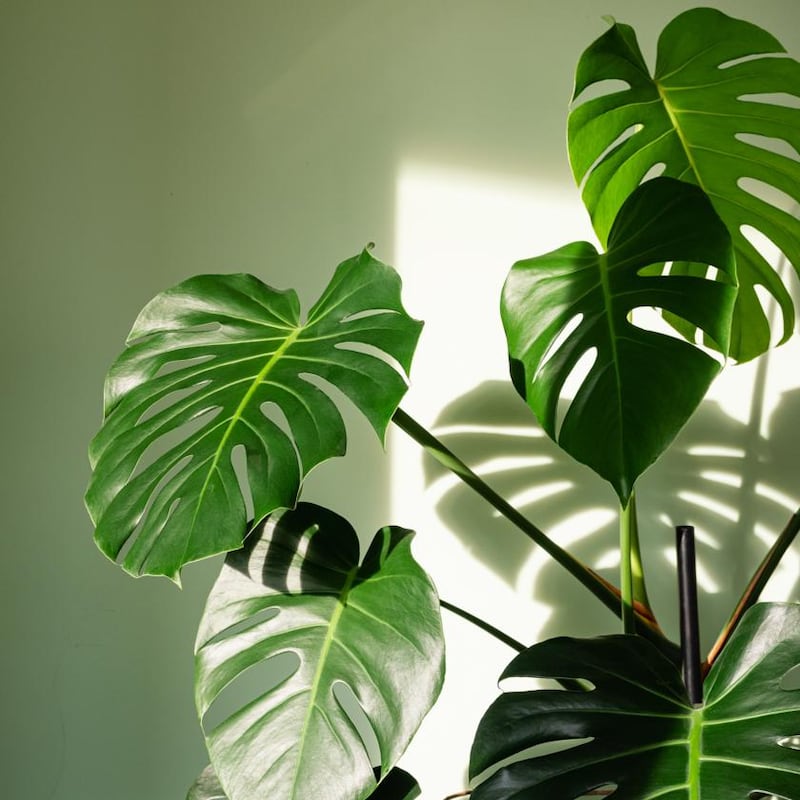Stepping into my friend’s apartment recently, I was struck by how she had the place filled with plants. She has a Philodendron Goeldii, a fiddly fig, a winter cactus, devil’s ivy, a spider plant, a mini palm tree and more. They’re not small little things on corners of bookshelves. Some of them are large and imposing. They envelope the space.
The couch, the TV and the other bits of furniture seem like accessories in their midst. They are merely functional, while the plants impose their presence on the room.
And yet I’m not overwhelmed by it, they give the room structure and atmosphere. There is a moodiness to the large, dark leaves of the Philodendron Goeldii which bend over the couch creating a cosy nook – a perfect spot to curl up with a book and coffee. The fiddly fig stands proudly beside the TV, like a sentry guarding the way to the balcony. They elevate the space, bringing nature to the livingroom.
Houseplants are increasingly popular with people in their 20s and 30s. If you search for houseplants on Instagram or TikTok, you’ll get plenty of accounts dedicated to teaching you how to maintain them. But why are so many young people choosing to keep them?
READ MORE
For Rachel Purcell (sister of 2fm presenter Roz Purcell) it started over Covid. “We had just moved houses in Dublin, and I wanted to create a nice atmosphere and environment inside,” Purcell says.
“I love being outdoors and when we couldn’t go very far, I wanted to try re-create some nature indoors.”
The 36-year-old also feels like it decorates her home without the need for a lot of stuff. “I don’t love lots of clutter, but I love having what feels like a bit of the outdoors inside,” she says.
It wasn’t all plain sailing though, as any houseplant enthusiast will tell you. Every plant has preferences for how much light and water they need. Some are a little bit tolerant of suboptimal conditions, but all plants will show signs of distress if not cared for properly.
Purcell says her learning curve was a fern. “It was so hard to keep. I didn’t know about placement and feeding. That didn’t go so well, and I haven’t had a fern since,” she laughs.

After that, Purcell focused on educating herself about light placement and watering and soon, she got into a rhythm. “I have a routine with them. On Fridays, I water my plants,” she says.
Purcell has three dogs, so she is very conscious of buying pet-friendly plants. If you decide to go for plants that are not animal friendly, it is important to put them in areas where the animals don’t go, she says.
She recommends teaching yourself by going online, and researching plants you want to buy, before buying them.
“You need to know where you should put [it], what resources it needs, the diseases it can get or about the bugs it can attract,” Purcell says.
“I once brought a plant home with bugs on it, and I didn’t realise they were there. It started to spread to other plants. That was a battle to get rid of the bug. It honestly nearly killed me.”
Purcell had to separate the affected plant and wash it in the shower and use a special oil. It took about four to five weeks to restore its health. “It was a good result in the end, but I never want to go through that again.”
When it comes to special food to help her plants grow, Purcell uses an Irish brand called Nature Safe. “It’s pet safe, but I am still mindful of where I spray it. I make sure they are not near the plants when it’s getting sprayed,” she says.
Since moving back to Tipperary with her partner, Purcell has embraced growing vegetables in her big garden, but she still loves her house plants. And her partner?
“He says no more plants in the bedroom, but he loves them.”
Interior designer Sofia Scatto, owner of crocaiistudio, first turned to plants because she moved from the Tuscan countryside and they always made her “feel calm”.
After living in Mexico for a few years, and moving to Belgium, she wanted “to bring a bit of the jungle with her”, so she went about getting plants that reminded her of Mexico.
“My monstera, the calatheas, livinstonia fan palm. It was more anything green that was tropical – which is most indoor plants. Interesting and variegated foliage was something I was really keen on, hence all the calatheas, they have great patterns,” she says.
When the 34-year-old moved to Dublin in 2018, she continued her love of plants in her studio apartment in Ranelagh.
Although Scatto could not bring many of her plants with her to Ireland, she has since rebuilt her collection and has started some rose bushes in the small garden she has in Dublin 6.
“My first plant in Ireland was a monstera which is now taller than me. I have about 11 plants in the apartment, and I love having them all around me,” she says.
How does she maintain her plants? “At first, I think I was projecting my anxious attachment on to my plants and I was watering them too much. They need less than you think.”
Scatto talks about research carried out on the effects plants have on stress, healing and recovery. One 2015 study, published in the Journal of Physiological Anthropology, found the presence of plants can have a calming effect on people. Other research suggests enhanced health outcomes for patients recovering from surgery when plants or flowers are in their room.
This makes sense to Scatto, as she has always found being in her homes in different countries quite calming, and she credits this to her abundance of houseplants.
“I couldn’t live without plants; they give me so much joy. I would have more space without them, but it’s space well spent,” she says.
Jonathan Twomey has always been interested in plants, but he got more into it during the pandemic.
“When Covid hit, I ended up needing to live alone throughout the first three months of the lockdown without any real human interaction, save for the odd ‘hello’ or ‘thanks’ with my local shopkeeper,” Twomey recalls.
“That experience was quite a lonely one, so when the garden centres opened, I just decided to take the opportunity to buy some plants and see how I got on.
“I really enjoy seeing them grow and change as the year goes on, and as they come and go. It’s incredibly satisfying even being able to keep them alive in the first place.”
Twomey says it is disappointing when plants die because of an easy mistake, like giving them too much or too little water, but it’s “all part of the learning experience”.
“I had a tragic under-watering disaster when I went away on holiday and came back to what can only be described as a withered wasteland,” he says.
According to Twomey, getting a routine can be tough, because each plant has different needs.
“I have 10 plants right now, but at one point I had around 15/16. Setting a routine can be tricky as each plant will have its own requirements for watering, but I’ll generally just check how dry the soil is, and how the leaves are doing,” he says.
“If the top few centimetres of the soil is dry, I’ll generally give it a water. Depending on the season, I’ll give them some plant food too. In the summer I’ll feed and water them more frequently, as the sun is more intense, so the plants drink more.”
Houseplants for beginners

For anyone starting out, Purcell recommends a snake plant due its tolerance for low light, a Pothos which is one of her favourites and a Chinese evergreen, for its big, luscious leaves.
For those feeling a bit braver, she says a Bird of Paradise is a showstopper of a plant, and it is on her wish list.
Scatto also recommends a snake plant, a monstera and a fern to start with.
Peace Lilies are Twomey’s favourite, and he recommends them for beginners. It was the first plant he bought during Covid, and it has grown from a tiny pot with a few leaves, to a much larger 22cm pot, and regularly flowers.
“It was one of the plants that survived The Great Drought of 2022 too, so I really want to keep it going as long as I can,” Twomey says.
He also suggests any calathea as a nice starter plant, “as they kind of dance as the sun changes which is cool” and are very low maintenance.
“Aloe vera plants are also very easy and need much less water than most, so if you think you will starve your plants first time, this is the right one for you.”
Scatto’s tips for maintaining houseplants
- Understand the sun needs of your plant. A monstera can get sunburned because they live under large trees in nature, so Scatto recommends more indirect light.
- A plant is more likely to die from overwatering than underwatering. Try to underwater a little at the start and watch how they react.
- Do not start with herbs – they are very hard to keep and if you buy from a supermarket, you have to split and repot them immediately because it will be too crowded in the small pot.
- Put some kitchen towel under a pot if you overwater to stop the roots from taking in too much water.




















